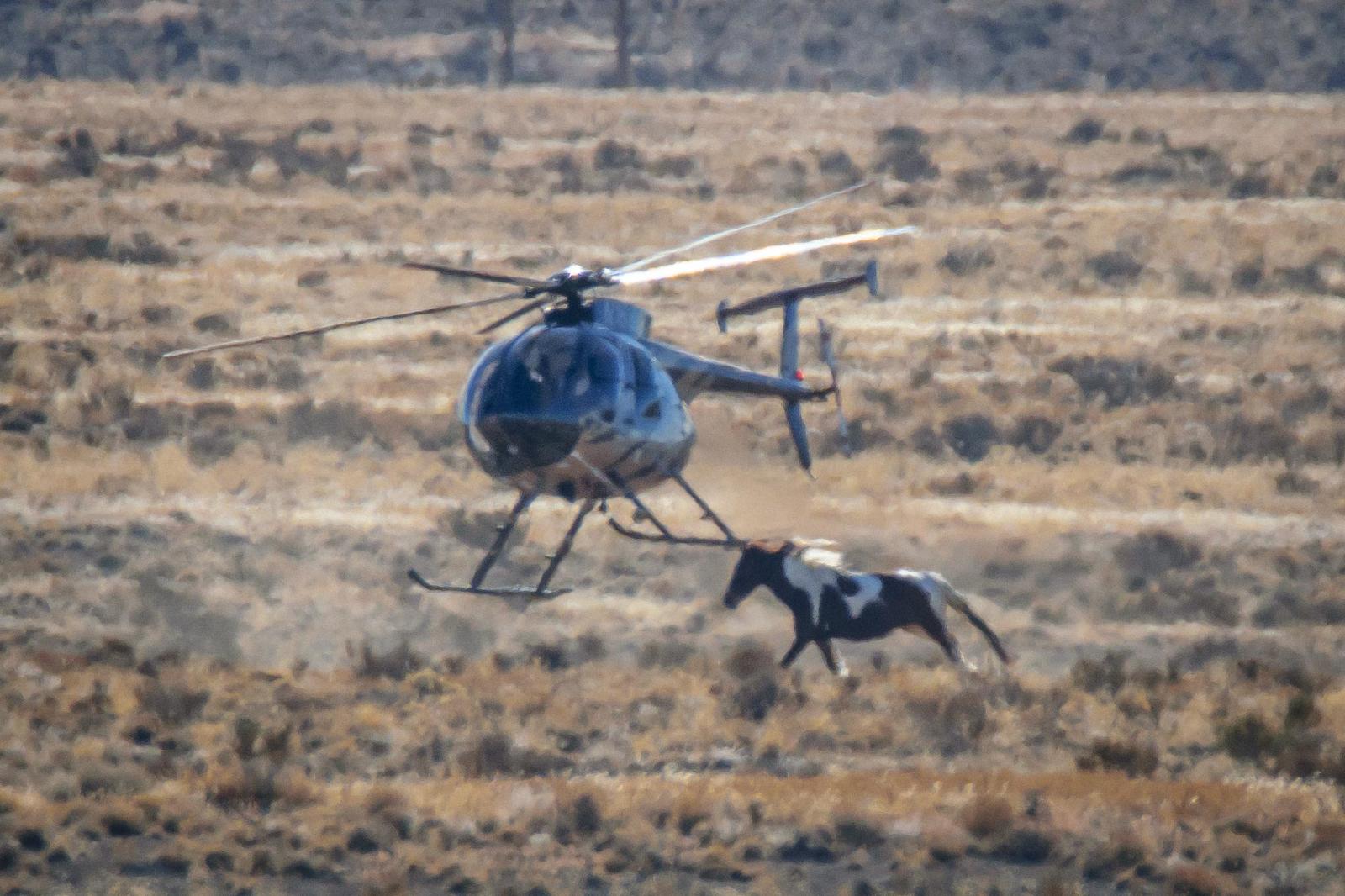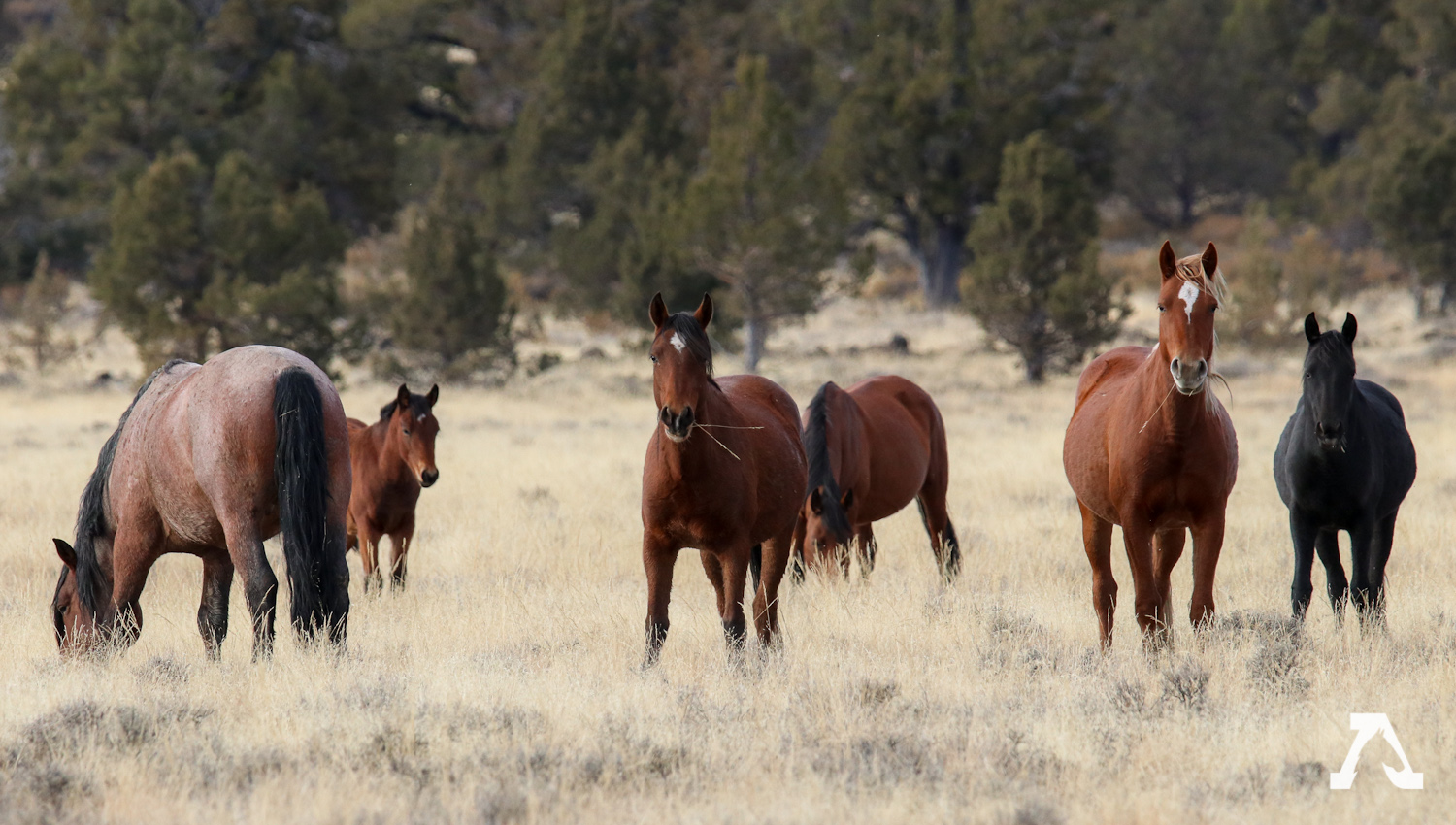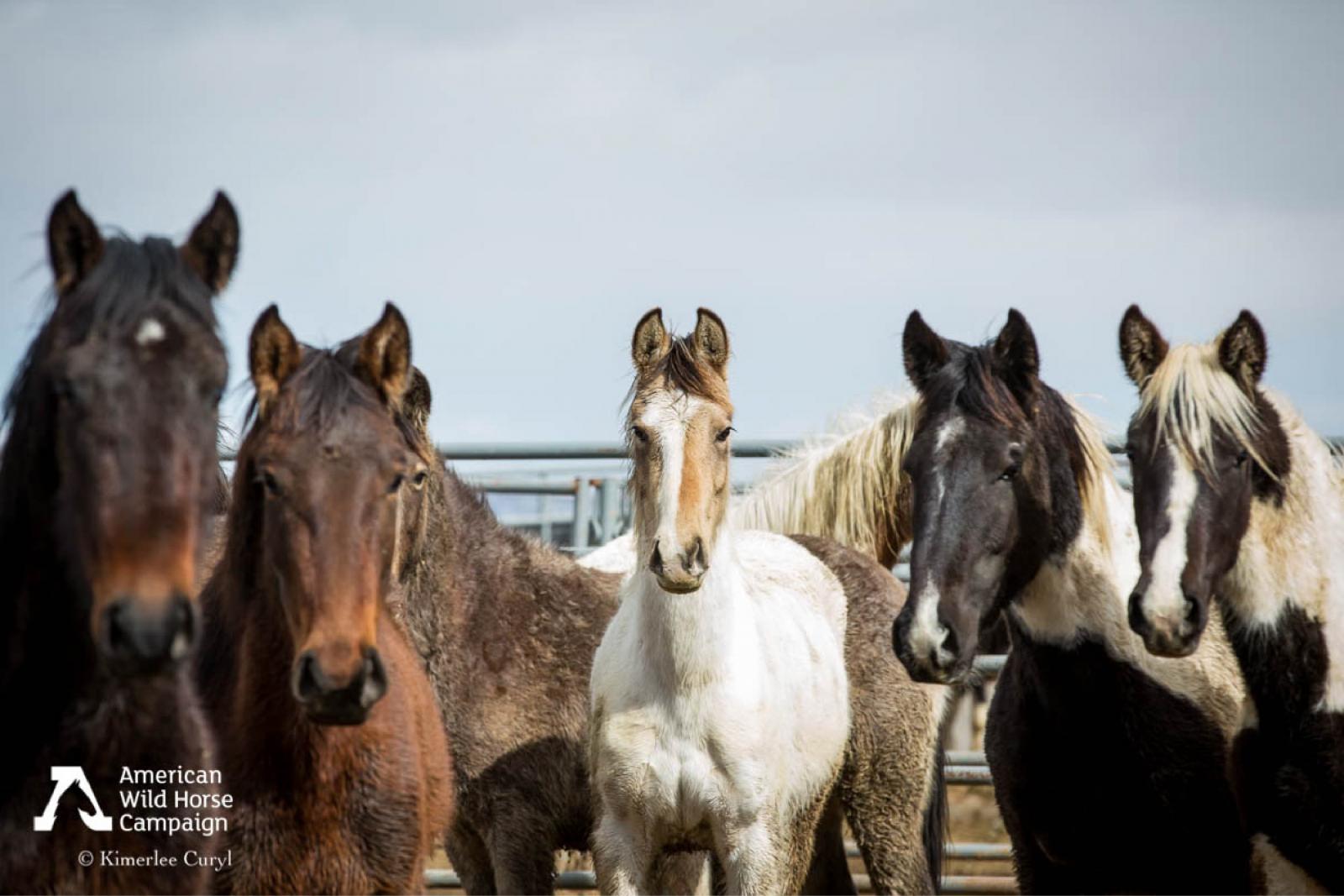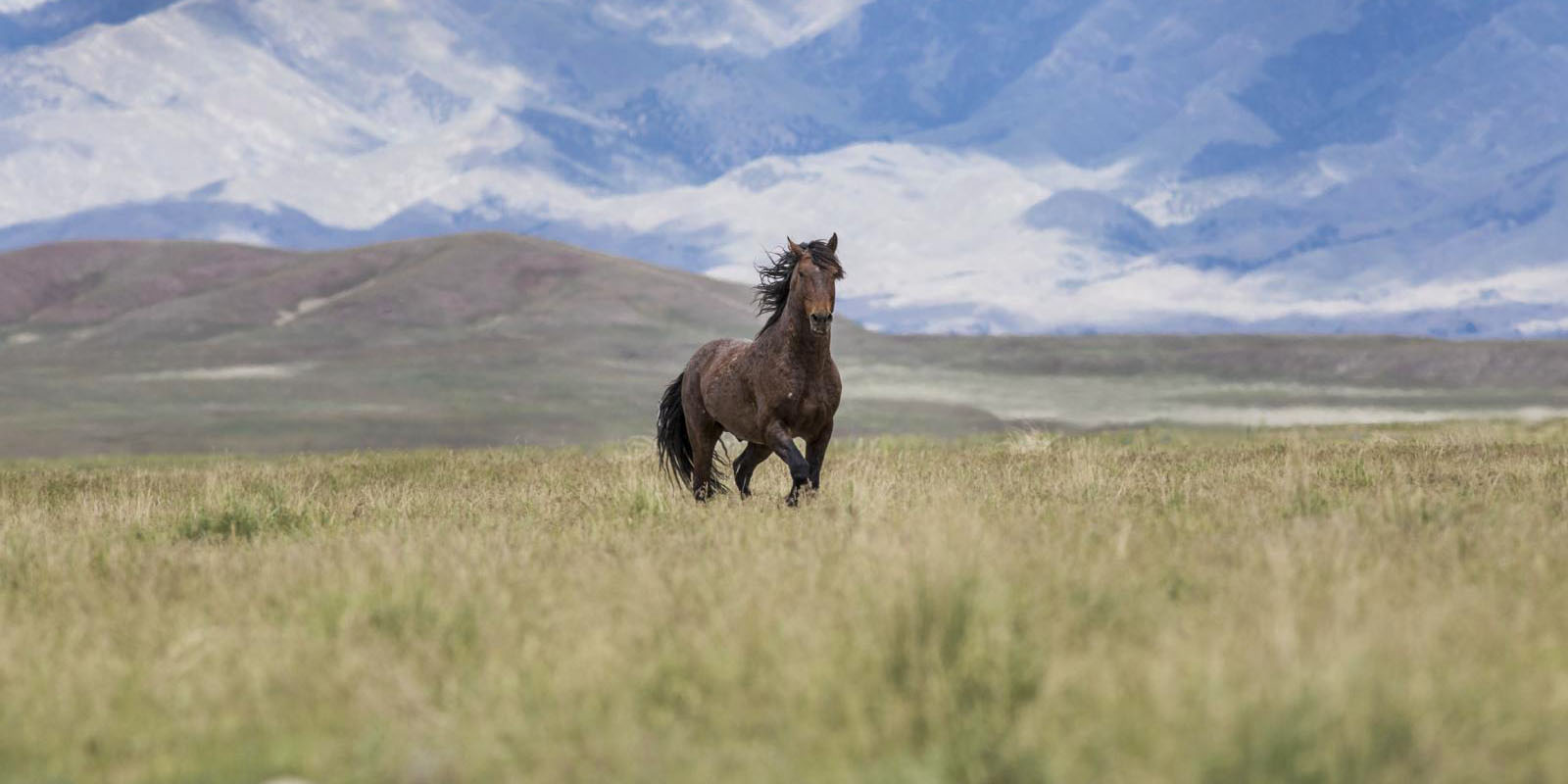BLM 2018 Data – More Mismanagement of Wild Horses and Burros
· Removals up nearly 70% from 2017.
· Number of horses and burros in holding facilities skyrockets to nearly 51,000.
· Number of mares vaccinated with fertility control drops.
· Adoptions drop while sales increase by 85%.
· Agency reverses 24-horse-per-sale policy and reinstates 4-horse-per-sale limit.
· Agency announces a plan to pay adopters $1,000 per horse.
(March 19, 2019) Data released by the Bureau of Land Management (BLM) on its Wild Horse and Burro Program for Fiscal Year (FY) 2018 confirms that the agency is continuing its mismanagement of our country’s iconic wild horses and burros on public lands. Massive roundups and removals and unpreceded sales coupled with the negligible use of fertility control resulted in a disastrous year for America’s wild herds.
ROUNDUPS AND REMOVALS

Despite warnings from the 2013 National Academy of Sciences (NAS) report on the BLM Wild Horse and Burro Program that roundups and removals actually facilitate high population growth rates on the range and are “expensive and unproductive for BLM and the public it serves,” the agency doubled down on this failed approach in FY 2018. All told, 11,472 animals – 9,749 horses and 1,723 burros – were permanently removed from public lands – the largest number in nearly a decade. The FY 2018 removal number represents almost three times the 4,209 animals removed in FY 2017.
With the almost 12,000 animals removed in FY 2018, the number of wild horses and burros warehoused in BLM holding facilities soared to 50,935, costing taxpayers about $50 million and consuming 61% of the $80 million budget for the entire BLM Wild Horse and Burro Program.
To expedite the removal of horses and burros from the range, the BLM increasingly used the “emergency” designation to conduct roundups after unexpected events, such a fire or drought, for non-emergency situations. As a result, the agency was able to avoid National Environmental Policy Act requirements for the analysis, disclosure, and public comment on roundups of federally-protected wild horses and burros from public land as well as ignore directives from its own management handbook.
The flimsiness of the agency’s “emergency” excuse for large removals was especially evident in Nevada, where an emergency removal of horses due to lack of water in the Antelope Herd Management Area (HMA) was only temporarily halted due to flooding from heavy rains. Additionally, the BLM claimed that horses in an area of the Antelope Valley Herd had no access to water and were in poor body condition. In reality, documentation from a local photographer demonstrated that horses there were in good condition with enough water to drink and roll around in.
The 2018 roundups and removals were also particularly brutal. First, the BLM regularly abused its authority to euthanize severely ill or injured horses by killing wild horses without sufficient justification. Roughly 181 horses were euthanized. In many of these cases, the pre-existing conditions were not fatal, and killing the horses could not be considered an act of mercy.
Second, was the treatment of the horses during helicopter roundups. AWHC had observers at virtually every BLM roundup that took place last year, and we sent multiple complaint letters to the BLM regarding violations of its own Comprehensive Animal Welfare Program standards and the Wild Free-Roaming Horse and Burro Act of 1971 during roundup operations. These violations included stampeding young foals with helicopters to the point of exhaustion and death, flying helicopters too close to horses, and causing horses to crash into barbed wire. During the roundup operation on the Red Desert HMA in Wyoming, for example, multiple foals died of “capture shock” (i.e. they were run to death), another foal with a broken fetlock was chased for miles, and a six-year-old stallion was injured and blinded by another stallion on a trailer. Both the foal and stallion were euthanized.
FERTILITY CONTROL

Not surprisingly, 2018 marked yet another year when the BLM ignored recommendations from the 2013 NAS report to increase the use of fertility control as a “more affordable option” over the long term “than continuing to remove horses to long-term holding facilities.”
In FY 2017, the BLM treated 777 mares with fertility control, the largest number since 2012 when 1,045 mares were vaccinated with PZP. But, in FY 2018, the number dropped to 702, with 690 mares being vaccinated with PZP and another 12 mares with GonaCon.
Instead of pursuing safe and humane methods to stabilize population growth rates, the BLM chose to continue its campaign to permanently sterilize mares by planning yet another study that would remove the ovaries of 100 captured mares from the Warm Springs HMA in Oregon. However, thanks to overwhelming public opposition and a lawsuit filed by AWHC, The Cloud Foundation, and The Animal Welfare Institute, the agency backed down on its plans for that risky and inhumane surgery – at least for now.
ADOPTIONS AND SALES

Even with the expansion of its internet adoptions, the opening of holding corrals previously closed to the public, and its partnerships with organizations, such as the Mustang Heritage Foundation, BLM’s record for horse and burro adoptions in FY 2018 was not stellar.
Only 3,158 animals were adopted into private homes – 2,459 horses and 699 burros. That number is down from FY 2017 when 2,905 horses and 612 burros were adopted for a total of 3,517 animals.
However, in FY 2018, sales of wild horses and burros were up, most likely with the help of a new BLM sales policy, Instruction Memorandum (IM) 2018-066, that was intended to increase the disposal of “excess” animals in order to decrease off-range holding costs. IM-2018 allowed a person or group to purchase up to 24 animals a day or 25 or more animals with special BLM approval – a dramatic reversal of the previous administration’s policy of limiting sales to 4 animals at a time every six months and 5 or more with special approval from the BLM.
In FY 2016, 211 animals (179 horses and 32 burros) were sold, on average for $25 each. A year later, that number rose to 582 (518 horses and 64 burros). But in FY 2018, the number skyrocketed to 1,451 animals (1,201 horses and 250 burros), representing almost a seven-fold increase from FY 2016 and a three-fold increase from FY 2017!
Also of concern: the BLM’s apparent effort to rapidly move horses from the adoption to sales category, increasing chances of horses being sold for slaughter.
The fee to adopt a horse from the BLM is $125 and the title is not transferred for a year until a compliance inspection ensures that proper care and treatment of the horse or burro is being provided by the adopter. A sale authority horse, on the other hand, is sold for $25, and the title is transferred immediately.
Under the Wild Free-Roaming Horse and Burro Act, as amended surreptitiously by the late Senator Conrad Burns, a Republican from Montana, horses, and burros are sale eligible if they are 10 years and older or if they are “three-strike” animals, meaning they have been unsuccessfully offered for adoption three times.
Over the last year, it appears that the BLM has accelerated its efforts to make horses and burros “three strike” animals in order to speed up their sale eligibility. For example, at a BLM adoption/sales event in Hallettsville, Texas last February, of the 35 wild horses and burros available for sale, 5 were yearlings!
In another instance, an eight-month-old filly removed in August 2018 from the Nevada Wild Horse Range during an “emergency” roundup ended up in Carter Livestock, a kill pen in Colorado, last month. So the question is – how do yearlings go through three adoption events and become sale eligible in one year or less?
AWHC has filed a Freedom of Information Act request to obtain records on the information for the BLM horses and burros sold in 2018, including those offered at the Hallettsville, Texas event.
2019 PLANS
· Roundups – The BLM’s tentative FY 2019 roundup targets just 2,537 wild horses and burros for removal, a significant decrease from last year. However, the agency’s “gather” schedule includes no plans to utilize fertility control. The roundup schedule also could be amended as the year proceeds to increase the number of horses removed from the range. Given the BLM’s misuse of the “emergency” roundup excuse, it’s difficult to predict how many animals will actually be removed from the range this year.
· Sales Policy Rescinded – On March 15, 2019, the BLM announced that it was rescinding its new sales policy allowing for the purchase of 24 horses at a time by an individual buyer, and has reinstated the four-horse-per-sale limit originally imposed by the Obama Administration to protect horses and burros from being sold for slaughter. This is a positive development brought about by public outrage and Congressional scrutiny.
· New Adoption Policy – Earlier this month, the BLM announced a new plan to pay adopters $1,000 to take horses – a move that could result in more failed adoptions by attracting adopters who lack the resources to care for a wild horse or burro.
· Fiscal Year 2020 Budget Cuts – The Trump Administration’s 2020 budget request to Congress includes a $5 million cut to the budget for the BLM Wild Horse and Burro Program. However, if the Report to Congress delivered by the BLM late last year is any indication, dangerous times lie ahead for our nation’s wild horses and burros. Every option in that report involved mass roundups, destruction of healthy horses, and surgical sterilization of remaining herds on the range.
Despite the many developments – good and bad – in the BLM Wild Horse and Burro Program, the agency is not making changes to the “business as usual practices” that the NAS warned about six years ago. Fundamentally, there has been no change to the roundup/remove and stockpile approach to wild horse management that the NAS concluded was actually making the problem worse by facilitating high population growth rates on the range. The BLM’s decrease in fertility control use remains the antithesis of the reform that the nation’s scientific body advised in its call to use science to improve this broken BLM program. In 2019, the BLM continues to ignore science, and the taxpayers and the wild horses and burros we care about continue to pay for the agency’s bad decisions and policies.


